Abstract
Oil-dependent countries face persistent challenges, such as energy supply–demand imbalances, overreliance on fossil fuels, declining economic diversification, and environmental degradation. In response, policymakers are increasingly advocating for comprehensive energy transitions to enhance energy and environmental security while promoting sustainable development. This study evaluates Iran’s energy transition through the modeling of five scenarios using the EnergyPLAN software V16.3. These scenarios, ranging from increased fossil fuel production to renewable energy deployment, subsidy reform, and energy efficiency, were developed based on a systematic literature review and expert interviews. Key indicators such as carbon emissions, primary energy demand, and supply–demand balance were used to assess the long-term impacts of each scenario through 2040. The Transition Scenario Policy (TSP), which integrates elements of all other scenarios, emerged as the most effective pathway for reducing emissions, correcting supply–demand imbalances, and aligning with sustainable development goals. The novelty of this study lies in its mixed-method approach, combining qualitative stakeholder insights with quantitative modeling, offering a replicable framework for energy transition planning in similar oil-dependent contexts. The practical implications support evidence-based policy making, while the results open avenues for future research on adaptive energy governance, policy trade-offs, and resilience under global uncertainty.
1. Introduction
The dual crises of climate change and energy security have intensified global interest in renewable energy as a strategic pathway to meet future energy demands. The concept of energy transition, shifting systematically from fossil fuel-based systems to low-carbon, renewable, and energy-efficient alternatives, has emerged as a cornerstone strategy for achieving long-term environmental sustainability, economic resilience, and robust energy security [1,2,3,4]. For oil-dependent countries, this transition presents both a significant opportunity and a considerable challenge: while rapid economic growth and the rising energy demand make the adoption of clean energy urgent, structural, institutional, and financial barriers often impede progress [3,4,5].
A wide array of policy instruments has been developed globally to mitigate emissions and enhance energy security. These include increasing renewable energy production, implementing renewable energy subsidies and carbon tariffs, reducing consumption rates, and improving energy efficiency [1,2]. In the United States, for instance, carbon reduction strategies include (i) the removal of subsidies for traditional power generation technologies, (ii) accurate electricity pricing, (iii) a nationwide feed-in tariff, and (iv) public awareness campaigns funded by a national fund [6,7,8]. Europe, meanwhile, emphasizes supply-side technologies and carbon-pricing mechanisms to drive the shift toward renewable energy [9,10]. Similar policy experimentation is ongoing in Asia, Africa, and South America, yet experts continue to debate the economic implications and effectiveness of these approaches [6].
Energy policy reforms, such as phasing out fossil fuel subsidies, enhancing energy efficiency, and investing in renewables, directly influence energy intensity, supply–demand balance, and emission levels. For oil-dependent nations, such reforms are especially critical. These countries often allocate substantial public funds to subsidize energy, primarily to achieve objectives like poverty reduction, industrial protection, job creation, and social equity [11,12,13]. However, such subsidies frequently result in wasteful energy use, environmental degradation, and fiscal pressure on state budgets [12,13,14,15,16,17].
Iran exemplifies these dilemmas. Despite possessing 9% of the world’s oil reserves and 16.1% of global natural gas reserves, it suffers from soaring energy demand and inefficient energy consumption practices [18]. Iran has the highest energy intensity in the Middle East, diverging sharply from global efficiency trends. Rapid urbanization and industrial growth have exacerbated these issues, threatened the nation’s energy security and amplifying its environmental footprint. For instance, per capita CO2 emissions from fuel combustion rose from 6.8 tons in 2008 to 7.76 tons in 2022 [18,19].
These challenges are rooted in broader structural issues linked to Iran’s resource dependency. The “resource curse” [20] has contributed to macroeconomic instability, overreliance on oil revenues, and limited economic diversification. At the same time, excessive fossil fuel subsidies have entrenched inefficient consumption patterns, with rising demand consistently outpacing supply. This imbalance has undermined both energy security and environmental integrity, making a comprehensive reform of Iran’s energy system a strategic necessity.
This study presents the first comprehensive and systematic assessment of Iran’s energy transition and evaluates policy options capable of correcting supply–demand imbalances and environmental degradation by looking at the related policies in oil-dependent countries. While the prior literature has primarily analyzed isolated policy instruments or single scenarios in oil-rich countries, this study addresses a critical knowledge gap by proposing and modeling five distinct policy scenarios tailored to Iran’s unique energy challenges. These scenarios are based on empirical data and modeled trends up to 2040, with projections of demand and supply–demand balances simulated.
The scenarios are as follows:
- The Increasing Oil and Gas Production Policy (IOGPP) focuses on increasing oil and gas production to meet internal demand and maintain export capacity.
- The Green Energy Policy (GEP) prioritizes investments in renewable technologies and low-carbon infrastructure to increase supply to meet internal demand in a sustainable way.
- The Phasing Out Subsidies on Fossil Fuels Policy (PSFFP) aims to decrease demand, rationalize energy markets, and alleviate fiscal burdens.
- The Increase Energy Efficiency Policy (IEEP) targets demand improvements across all sectors.
- The Transition Scenario Policy (TSP) integrates elements from all previous scenarios to offer a comprehensive, long-term path to sustainability.
These scenarios reflect a growing international consensus: effective energy governance requires a policy mix tailored to national conditions, underpinned by carbon pricing, renewable energy mandates, and institutional reform. For Iran, aligning energy policy with environmental, economic, and social priorities is vital not only for reducing emissions and complying with the Paris Agreement but also for ensuring long-term energy security and resilience.
The contributions of this study are threefold. First, a thorough review of the literature indexed in Scopus and ScienceDirect under the keywords “sustainable development” and “energy transition” was conducted to identify prevailing policy instruments. Second, stakeholder engagement was emphasized in the selection of evaluation indicators from reviewing the indexed paper in the first step to reduce researcher bias. Third, this study modeled five future scenarios, unlike conventional single-scenario approaches, accounting for the complex dependencies between energy consumption and national development. The modeling included projections of energy supply and demand and CO2 emissions across four key sectors: electricity, heating, transportation, and industry.
2. Literature Review
2.1. Sustainable Development and Energy Transition
Energy transition, particularly in oil-dependent economies, is a cornerstone of global sustainable development. The concept of sustainable development, as defined as emphasizing meeting current energy needs without compromising the ability of future generations to meet theirs [21]. Energy transition refers to the gradual shift from conventional fossil fuels to renewable, low-carbon energy sources. Globally, numerous studies have explored the role of energy transition in achieving the Sustainable Development Goals (SDGs), with a particular focus on reducing carbon emissions, improving energy efficiency, and ensuring equitable access to energy [3,4,5,22,23,24,25,26,27,28,29,30,31,32,33,34,35,36]. For oil-dependent countries, energy transition is particularly critical due to the dual challenge of reducing the reliance on fossil fuels while addressing economic and political vulnerabilities [37].
The geopolitics of the global energy transition has been a growing area of interest in recent years, with several studies exploring its implications for international relations, economic structures, and global governance. IRENA conducted one of the first comprehensive assessments, mapping how the rise of renewable energy and the decline of fossil fuels will reshape global power dynamics [22]. It further suggests that the transition may reduce conflicts driven by fossil fuel competition, though it highlights emerging security risks tied to the digitalization of the energy sector. Building on this, Goldthau et al. outlined four geopolitical scenarios for the energy transition by 2030 [38], ranging from full international cooperation to technological breakthroughs that could deepen global rivalry. Their analysis emphasized how different regions, such as Europe, the US, and China, will adapt to the transition based on their energy needs and technological capabilities. Hafner and Wochner also examined the drivers shaping the energy transition, focusing on the global energy demand, decarbonization policies, technological innovation, and market-driven digitalization [39]. Their study suggests that the global energy system will undergo significant changes, particularly due to the increasing role of renewable technologies and low-carbon solutions. These studies collectively highlight the complex and multifaceted nature of the energy transition and its geopolitical implications, underscoring the need for a more integrated approach to analyzing global energy governance [22,38,39].
2.2. Energy Transition Models
In recent years, energy transition models have become crucial tools for understanding and planning national energy pathways. The development of energy transition models is a complex task that demands a multidisciplinary approach involving energy engineering, economics, environmental science, and increasingly, energy systems engineering. Many researchers have insisted on transition models to project energy demand, CO2 emissions, and the adoption potential of renewable energy technologies [4,5,24,27,40,41,42,43]. These models must go beyond conventional decision variables, such as capacity, location, and cost optimization, to address environmental and social objectives, uncertainties, system flexibility, and the alignment between short- and long-term planning goals.
A wide range of energy transition models has emerged, differing in scope, methodologies, and planning horizons. Tools such as GEMS, MEGS, WASP, and HEMS are suited for real-time and mid-range optimization of grid-connected systems incorporating both renewable and thermal energy sources. For long-term strategic planning, widely adopted models include EnergyPLAN, MAED, MESSAGE, and LEAP. These models are essential for designing transition pathways that balance high shares of renewable energy with fossil fuel dynamics, technology costs, and the variability of zero or low-carbon options like renewable energies or cleaner fossil fuels [4,5,24,27,40,41,42,43,44]. Tools from process systems engineering, like multi-objective optimization, energy system analysis, and life cycle assessment, offer valuable capabilities; furthermore, multi-scenario approaches have become increasingly important for capturing uncertainties related to policy implementation and the transition to sustainable development [37,45]. These models enable policymakers to assess diverse policy pathways and evaluate trade-offs between economic growth, energy security, and environmental sustainability.
2.3. Energy Transition in Oil-Dependent Countries
Oil-dependent countries face unique challenges in transitioning their energy systems. These challenges often include entrenched fossil fuel subsidies, a lack of infrastructure for renewable energy, and a dependence on oil revenues for economic stability. Several studies have explored how these countries can navigate the transition while ensuring energy security and economic development, and balancing this development with climate goals. Similarly, many studies have pointed to the role of policy instruments, such as energy pricing reforms, renewable energy incentives, and energy efficiency measures, in mitigating the economic risks associated with fossil fuel dependency [3,46,47]. Stakeholder engagement has become a key component in energy transition modeling, especially in oil-dependent countries where political, social, and economic dynamics are critical to the success of policy interventions. Involving stakeholders ensures that the model reflects practical realities and avoids researcher bias. In the case of Iran, engaging key stakeholders such as policymakers, energy producers, and the general public can help design more effective policies and improve the overall validity of energy transition models. Studies have shown that participatory approaches in scenario modeling help ensure that energy transition pathways are both feasible and aligned with national priorities [37,47,48].
2.4. Energy Transition Policies for Mitigating Iran’s Energy Supply–Demand Imbalance and Environmental Issues
Iran’s energy transition is uniquely complex due to the country’s substantial dependence on oil and natural gas as dominant energy sources and the backbone of governance revenues. Researchers argue that a successful transition requires an integrated strategy combining technological innovation with robust policy reforms [49]. Despite considerable potential for renewable energy technologies, such as wind and solar, the country still faces major hurdles, including infrastructural deficiencies, regional inequalities, and entrenched energy subsidies [17,50,51,52,53]. These challenges underscore the importance of scenario-based modeling that accounts for Iran’s specific socio-economic and environmental characteristics in order to formulate feasible and effective transition pathways. Fossil fuels currently dominate the energy mix in Iran, powering the residential, commercial, and industrial sectors, as well as electricity generation and refinery operations. Natural gas, in particular, plays a central role, being the primary source of electricity generation [53], and is projected to become the leading fuel globally. Countries with large gas reserves, like Iran, have the potential to reshape global energy dynamics if they strategically leverage their resources [17,50].
In 2023, Iran consumed an average of 249 billion cubic meters of natural gas, with 119 billion cubic meters allocated for residential and commercial use, 51 billion for major industries, and 79 billion for power generation [51]. By 2024, Iran ranked third in global natural gas production, with an output of 259 billion cubic meters, making up 6.4% of the global supply. It also produced 81,157,000 barrels of oil and gas condensates per day in 2023, positioning it as the eighth-largest global producer. However, the country is grappling with severe imbalances in its energy system, especially regarding natural gas. Its daily petroleum consumption exceeds 250 million liters, over six times the global average [52], with gasoline consumption reaching 140 million liters per day in 2024, a 13.5% increase from previous years. This has led to a daily deficit of 10 million liters. Similarly, the natural gas imbalance hit 350 million cubic meters in 2024 and is projected to escalate to 453 million and 600 million cubic meters by 2031 and 2040, respectively. The residential and commercial sectors remain the highest consumers, but inefficiencies and low productivity across the system are the root causes of these imbalances [52]. By 2040, the projected energy gap will include 2.4 million barrels per day for oil, 40,000 megawatts for electricity, and 512 million cubic meters per day for natural gas (Figure 1, Figure 2 and Figure 3), highlighting a widening divergence between production and consumption [17,50,51,52,53]. These projections were made by the author based on an analysis of historical consumption patterns, sector-specific demand trajectories, and current production capacities, assuming no significant technological or policy changes. The forecast accounts for the increasing demand in the residential, commercial, industrial, and power generation sectors, along with persistent inefficiencies and limited productivity improvements. As such, the author predicted Iran’s demand and supply of oil, gas, and power according to energy data without comprehensive reforms. These figures illustrate that the supply–demand imbalance will deepen by 2040, which will pose serious challenges to Iran’s energy security and sustainable development [17,50,51,52,53].
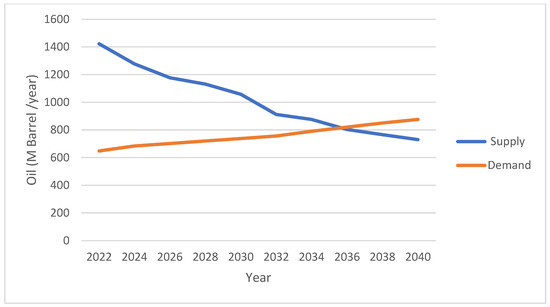
Figure 1.
Oil production in oil-dependent countries based on current conditions until the year 2040.
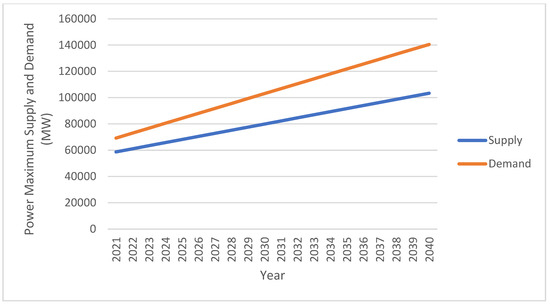
Figure 2.
Electricity supply and demand based on current conditions until the year 2040.
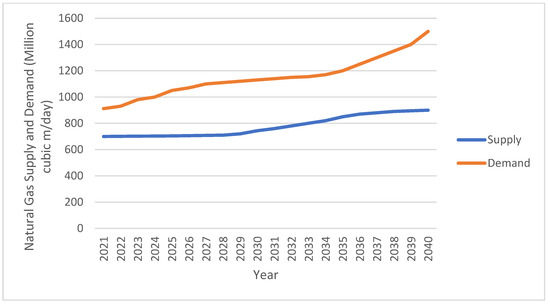
Figure 3.
Natural gas supply and demand based on current conditions until the year 2040.
The main source of gas in Iran is the South Pars gas field, which supplies about 70% of the country’s gas needs. Additionally, 30% of gas is sourced from other fields [53]. According to forecasts, Iran’s production from South Pars will face a decline due to a reservoir pressure drop, which must be considered when predicting the future state of the country’s gas supply [50]. Furthermore, to maintain current oil production levels, about 80% of the active oil fields in the country, which are in the second half of their lifespan, require significant amounts of gas injection to neutralize the adverse effects of the natural decline in production from these older fields. Therefore, any increase in natural gas production under the current conditions is a challenging and unlikely endeavor unless all investments and resources from the Ministry of Oil are redirected from other upstream and downstream sectors to focus solely on gas production, which is unreasonable and unfeasible [14,54]. It seems that without investment (from any financial source, whether domestic or foreign), maintaining and continuing production from the country’s gas fields will be very difficult. However, the lack of a tangible increase in the gas supply capacity, the decline in production pressure from South Pars, and the rising consumption have posed a serious challenge to the gas supply in the country [17]. The other challenges that have so far hindered the development of gas storage capacity in the country have been the lack of coordination among the subsidiaries of the Ministry of Oil. In light of the necessity to develop the country’s storage capacity during the seventh development plan, necessary coordination must be established among the subsidiaries of the Ministry of Oil. Good energy governance is the primary factor in strategic policy making that provides a foundation for economic development, sustainable development, and social justice [55,56]. This domain oversees multi-level, multi-dimensional, inter-policy-making, inter-sectoral, and cross-sectoral actions among the government, citizens, civil society, and the private sector. Good energy governance must meet the multifaceted and multi-level needs of the political–geographical space across six geographical scales, from local to global, ensuring balanced development at both local and national levels [57]. At the national level, it should lead to efficient and effective processing in the production, distribution, consumption, and export chain while sustainably meeting the needs of citizens in a way that enhances quality of life and public satisfaction, which forms the basis of governance philosophy [58]. This approach should ensure environmental sustainability and contribute to national survival. Additionally, at the transnational level, it should leverage the national [59], which has strategic intrinsic value and is considered a component of power from a geopolitical weight perspective, as a resource for peace and a means of regional integration among gas-producing and -exporting countries.
In the context of implementing good energy transition governance, optimizing energy consumption and maintaining balance in energy production and consumption is a fundamental challenge. Managing imbalances, increasing energy security, and sustainable development require the involvement of all stakeholders in power production from renewable sources [40,60,61,62,63,64]. The share of renewable energies in Iran’s energy production is neglected, as shown in Figure 4 and Figure 5. Also, the construction of more efficient power plants using oil and gas resources and high-efficiency distribution [65] is required. Figure 6 shows the losses in distribution networks in Iran that need to be reduced.
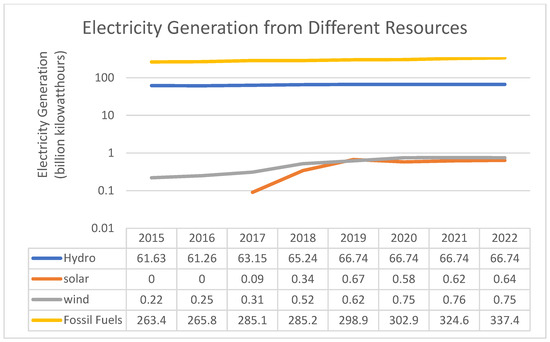
Figure 4.
Iran’s electricity generation from different resources [53].
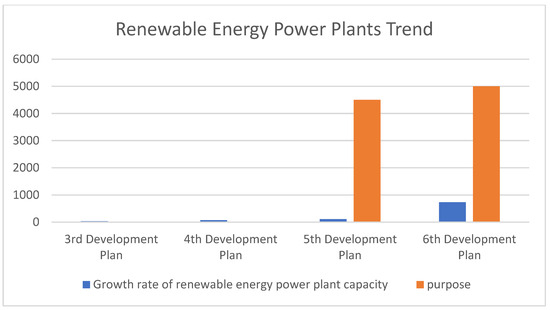
Figure 5.
Iran’s renewable energy power plants trend [53].
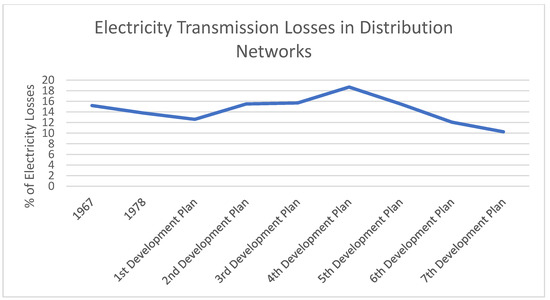
Figure 6.
Electricity transmission losses in distribution networks [53].
3. Materials and Methods
This study was structured around three core methodological components, aligned with the main contributions of this research. First, a comprehensive literature review was conducted using the Scopus and ScienceDirect databases, focusing on publications with the keywords “sustainable development” and “energy transition”. The analysis demonstrated a significant growth in academic attention to these topics: from a single publication in 2000 to 68 in 2024, an increase of 67 times (Figure 7). This upward trend reflects the global urgency of transitioning to sustainable energy systems. The reviewed literature was categorized into key conceptual domains that form the analytical foundation of this study:
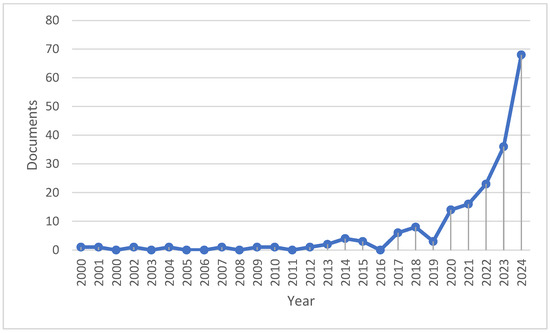
Figure 7.
The publication activity on “sustainable development” and “energy transition” issues (based on Scopus and Science Direct data).
- The Sustainable Development Goals (SDGs) and energy [23,24];
- Energy scenarios and decision-making approaches [25,26,27];
- Energy policy frameworks and evaluation, including scenario analysis and modeling for strategic planning [28,29];
- Environmental and socio-economic impacts, especially the environmental costs of fossil fuel dependence [30,31];
- Energy transition scenario analysis [24,66];
- Regional and global policy perspectives [32,33,34].
Second, the selection of evaluation indicators was conducted with a strong emphasis on stakeholder engagement. At an early stage of this research, policymakers, energy experts, and academic researchers were consulted to ensure that the indicators used in the scenario modeling reflected practical relevance, aligned with national energy-planning priorities, and helped minimize researcher bias. This participatory approach not only enhanced the validity of the findings but also strengthened the real-world applicability of the proposed policy pathways. Building on this foundation and informed by a comprehensive review of the existing literature, key energy transition policies were identified and systematically analyzed. These policies formed the basis for designing policy-based scenarios tailored to Iran’s context as an oil-dependent country. The scenarios were developed by assessing the diverse dependencies between energy consumption patterns and national development trajectories, allowing for the projection of the future energy demand, carbon dioxide emissions, and energy balance outcomes under various energy transition pathways.
The selected evaluation indicators included metrics related to energy intensity, CO2 emissions per sector, renewable energy share, energy import dependency, energy efficiency levels, and investment in clean technologies. These indicators were chosen based on both stakeholder consensus and their relevance in existing global frameworks such as the Sustainable Development Goals (SDGs), particularly SDG 7 (affordable and clean energy) and SDG 13 (climate action) [3,4,5,22,23,24,25,26,27,28,29,30,31,32,33,34,35,36]. Consistent with the existing literature [41], seven primary stakeholder groups were considered: industrial users, energy producers, public decision-makers, professional interest groups (e.g., engineering firms), the general public, distribution and transmission professionals, and non-governmental organizations (NGOs). The stakeholders’ input was used to determine the most effective policies for mitigating energy imbalances and promoting environmental sustainability. A summary of these policy priorities is provided in Table 1.

Table 1.
Summary of challenges, indicators, and related key policies extracted from 26 final papers about energy transition and their implications.
Third, once the key policies were validated through stakeholder input, five scenarios were developed. Each scenario was modeled based on anticipated carbon emissions and energy demand drivers influenced by the proposed policies. A crucial step in this process was mapping the reference energy system, including a structured representation of energy levels, carrier flows, technologies, and types of end-use energy across Iran. To simulate and optimize these scenarios, a bottom-up linear programming optimization model was employed, enabling projections of long-term energy trends. Carbon emissions and potential energy savings under each policy scenario were estimated using the EnergyPLAN software. EnergyPLAN is a free, open-access energy system analysis tool developed by the Sustainable Energy Planning Research Group at Aalborg University in collaboration with PlanEnergi and EMD A/S, Denmark. It is specifically designed to support the development of high-renewable-share sustainable energy systems [3].
Unlike conventional single-scenario approaches, this study’s multi-scenario modeling captures the complex interdependencies between energy consumption and national development trends. The projections extend to 2040, including simulations of energy demand, CO2 emissions, and energy supply–demand dynamics across four critical sectors: electricity, heating, transportation, and industry. The key policies and their implications are summarized in Table 1; this disaggregation enabled the sector-specific modeling of Iran’s energy transition. In the electricity sector, indicators such as per capita energy use, conversion efficiency, and renewable share guided policies on grid upgrades and fossil fuel subsidy reductions. The heating sector incorporated energy prices, affordability, and household accessibility, with pathways involving electric heat pumps and solar thermal systems. In transportation, the modeling focused on fuel switching, electrification, and energy demand in the service sector, supported by environmental taxes and infrastructure investments. The industrial sector addressed energy intensity, productivity, and renewable uptake, emphasizing clean fuel adoption and efficiency improvements. This sectoral structuring enhanced the model’s ability to simulate realistic, policy-relevant transition pathways.
4. Results and Discussion
4.1. Iran’s Energy Transition Scenarios
As outlined in the Materials and Methods Section, this research began with a systematic review of indexed academic papers to identify energy-transition-related policies relevant to oil-dependent countries and Iran as a case study. This was followed by semi-structured interviews with national energy experts to validate and prioritize the identified policy directions. Based on this multi-step process, five strategic scenarios were developed, each aimed at promoting sustainable development and addressing the persistent supply–demand imbalance in Iran’s energy sector. These scenarios collectively capture the key dimensions of Iran’s national energy governance, including institutional management, policy-making frameworks, regulatory mechanisms, energy supply structures, and demand-side dynamics.
Based on the model outputs, strategic policy recommendations were proposed to guide Iran and similarly oil-dependent countries toward a more sustainable and balanced energy future. The overall methodology adopted in this study is illustrated in Figure 8, which provides a schematic overview of the scenario development and assessment process. Oil-dependent countries often struggle to balance economic growth with sustainable energy development. In this context, robust scenario development methodologies can play a pivotal role in achieving energy security and supply–demand equilibrium without compromising environmental goals. The key challenges, policy indicators, and relevant interventions are summarized in Table 1, highlighting that effective energy transition strategies must be rooted in sustainability principles, account for socio-economic and environmental impacts, and be reinforced by strong policy frameworks. Although the transition to renewable energy presents substantial challenges, it also delivers significant benefits, including reduced emissions, enhanced energy efficiency, and long-term economic resilience.
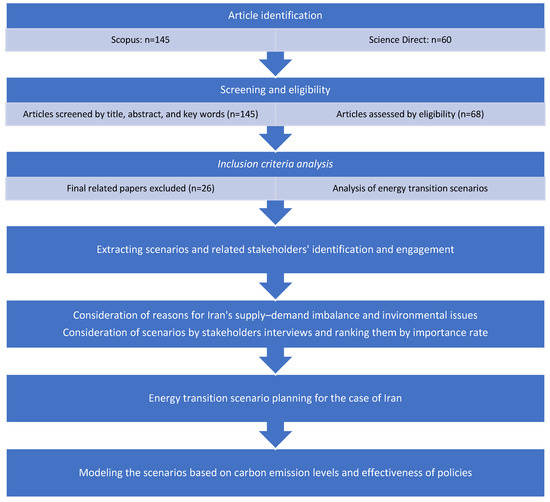
Figure 8.
Schematic representation of the implemented methodology.
The five scenarios presented in Table 2 are derived from an initial set of eight policy directions, which were identified through a systematic review of 26 academic articles and refined through expert interviews. Based on feasibility, stakeholder consensus, and alignment with national strategic priorities, these policies were prioritized and developed into integrated transition scenarios. Each scenario represents a distinct strategic pathway to address oil-dependent countries’ energy challenges, including decarbonization, diversification, and energy security.

Table 2.
Summary of key energy transition scenarios for oil-dependent countries and their implications.
While these scenarios differ in their core objectives, ranging from the continued use of fossil fuels to the promotion of renewables and energy efficiency, they were evaluated using a unified analytical framework. This framework assessed carbon emissions, the supply–demand balance, and alignment with sustainable development goals (SDGs). Such an approach enabled a comprehensive comparison, revealing trade-offs and synergies among the scenarios, and directly addressing the projected energy imbalance in Iran, defined as the widening gap between the energy supply and demand by 2040.
4.1.1. Increasing Oil and Gas Production Policy (IOGPP)
Any increase in natural gas production under current conditions presents a significant challenge, perhaps even an impossibility, unless all investments and resources from other upstream and downstream oil ministry sectors are redirected toward gas production, which is neither rational nor feasible. Without investment (whether from domestic or foreign sources), maintaining and continuing production from the country’s gas fields (at least in the short-to-medium term) will be highly difficult. The lack of a tangible increase in the gas supply capacity, declining production pressure from the South Pars field, especially during colder months, and rising consumption have created a serious challenge for the country’s gas supply [50].
4.1.2. Green Energy Policy (GEP)
In Iran’s green energy transition, all the thermal power plants have been a defining characteristic of its electricity supply mix. Oil- and gas-fired power plants are the primary contributors to electricity generation. This trend is expected to continue through 2040, with gas-fired plants remaining the primary source of electricity, but energy imbalance, especially in natural gas resources, and environmental pollution have forced the country to change the energy mix and increase the share of renewable energies for electricity production. Iran is also preparing to transition toward low-carbon technologies in the 2040s, in line with the global goal to reduce carbon emissions under the Paris Agreement. The effective replacement of thermal power plants by cleaner energy sources will not be fully realized until after 2030, as the anticipated increase in low-carbon technologies, such as nuclear, hydropower, solar, wind, biofuels, and geothermal, is expected to take time to significantly increase electricity generation.
4.1.3. Phasing Out Subsidies on Fossil Fuels Policy (PSFFP)
Iran’s energy governance system, like those of many other oil-dependent countries, is primarily designed to increase energy access for low-income groups, protect domestic industries from international competition, create employment, stimulate economic growth, stabilize prices, and promote social equity [12,13]. However, energy subsidies can lead to inefficient use and energy wastage, which, in turn, increases pollution levels [12,13,14]. The financial sources of these subsidies vary across countries and are influenced by factors such as state ownership of the energy sector, government fiscal conditions, and energy import–export dynamics [15]. In recent years, subsidies have exerted significant pressure on the government budget, raising doubts about their necessity [16,17]. This has led policymakers to consider reforms aimed at adjusting energy prices and reducing subsidies [50].
4.1.4. Increase Energy Efficiency Policy (IEEP)
Since energy efficiency plays a crucial role in achieving energy consumption reduction and emission reduction goals, a relatively broad spectrum of policies is needed, requiring a combination of multiple tools. No single policy instrument alone can fully achieve energy efficiency goals [57]. This scenario was designed based on this overarching policy and may include a combination of regulations, standards, policies, and monitoring systems. Figure 6 illustrates only distribution and transmission losses, which also include production and consumer losses across industries, agriculture, and households. Since this policy is highly feasible and can be implemented through a combination of regulations, standards, policies, and monitoring systems, it was incorporated into the GEP scenario.
4.1.5. Transition Scenario Policy (TSP)
In recent years, numerous studies have been conducted on the need for renewable energy sources in both oil-dependent and non-oil-dependent countries. Some of these studies have examined the nature of opposition to renewable energy infrastructure projects and factors that could enhance public acceptance. Evidence suggests that issues related to ownership and community participation can improve acceptance within communities. Additionally, residents tend to have a more favorable view of renewable energy installations when these projects improve their quality of life through benefits such as increased local income, improved electricity access, and enhanced infrastructure [65,67,68,69]. The shift toward renewable energy production presents a major challenge in transitioning from fossil fuels and conventional technologies. Instead, reconfiguration has been recognized as a transition pathway, requiring both private and public sector engagement. The adoption of new technologies has primarily been driven by key private sector players, who have leveraged their existing capabilities, upgraded their expertise, and designed hybrid solutions that integrate new advancements with established knowledge to create innovative products. This challenge has prompted electricity companies worldwide to move toward renewable energy sources [63]. Energy transition policies aim to accelerate the shift to renewable energy, ensure energy security, reduce energy consumption, enhance energy efficiency, reduce greenhouse gas emissions, and foster economic growth. Achieving a balance between these objectives while addressing concerns from various stakeholders (including local communities, industry actors, and policymakers) requires careful planning and execution. Despite the targets set in Iran’s Sixth Development Plan, which is shown in Figure 5, which aimed for renewables to comprise 5% of the energy mix, their current share remains below 1%, indicating a long road ahead for renewable energy development.
4.2. Iran’s Energy Transition Scenarios for Sustainable Development
To design and localize energy transition scenarios for Iran, a structured analytical model was developed, integrating both supply and demand modules with a particular focus on carbon emission trajectories and their implications for long-term supply–demand imbalances. A reference energy system (RES) was constructed using the EnergyPLAN software to map the flow of energy carriers, technologies, and final energy uses across sectors, providing a holistic and consistent representation of Iran’s energy system. Based on the extracted scenarios and analysis of the national context, each scenario addresses the projected energy imbalance by 2040 while aiming to reduce environmental pollutants. The outcomes of these scenarios are detailed in Table 3.

Table 3.
Iran’s energy transition scenarios for sustainable development and their policies and objectives.
The five energy transition scenarios for Iran consisted of the Increasing Oil and Gas Production Policy (IOGPP), the Green Energy Policy (GEP), the Phasing Out Fossil Fuel Subsidies Policy (PSFFP), the Increase Energy Efficiency Policy (IEEP), and the Transition Scenario Policy (TSP), presenting distinct strategies to address Iran’s pressing energy and environmental challenges. Each scenario offers specific benefits and trade-offs across carbon emissions, economic resilience, energy security, and alignment with long-term sustainable development goals (SDGs), and could also balance the energy supply and demand, which is the most important challenge in Iran’s energy sector.
- The IOGPP could increase the energy supply and enhance short-term energy security and economic revenues through expanded fossil fuel production, but it results in high carbon emissions and undermines Iran’s international environmental commitments. It also increases the risk of lock-in to a carbon-intensive energy infrastructure.
- The GEP prioritizes large-scale renewable energy deployment, which significantly reduces emissions, supports environmental goals, and increases the energy supply by using clean energy. However, it demands major initial investments and systemic reforms, including upgrades to grid infrastructure and energy storage systems.
- The PSFFP focuses on gradually removing fossil fuel subsidies, encouraging energy efficiency, reducing fiscal burdens, and decreasing the energy demand. While this approach promotes market efficiency, it may increase energy poverty and social resistance without adequate compensatory policies.
- The IEEP targets demand-side efficiency improvements, leading to lower emissions and energy savings, and, as a result, reduces the energy demand. Though it does not directly change the energy mix, it synergizes well with the GEP and PSFFP, amplifying their overall effectiveness. Implementation challenges include financing retrofits and fostering behavioral change.
- The TSP combines elements of sustainable strategies to deliver a supply–demand-balanced and phased approach. It integrates renewable expansion, fossil fuel rationalization, subsidy reforms, and energy efficiency to maximize synergies and minimize disruptions. As the most comprehensive scenario, the TSP addresses both environmental sustainability and supply–demand imbalances.
These scenarios could have synergies and trade-offs; for instance, synergies emerge through the scenario integration of the GEP and IEEP, promoting a clean, demand-responsive system. Also, the integration of the PSFFP and IEEP drives long-term structural reform through economic signals and strategic investment. Also, the trade-offs include economic feasibility under the IOGPP versus environmental performance under the GEP and IEEP, and potential social equity issues in the PSFFP without targeted compensation.
Most studies highlight the immediate effects of these scenarios on sustainability [14,42,64,65]. As shown in Figure 9, reform-oriented scenarios, particularly the TSP, are expected to deliver the most substantial environmental benefits by 2040. Specifically, CO2 reduction under the TSP scenario is projected to reach 600 million tons annually by 2040. However, achieving these long-term benefits is contingent on economic, political, and technological factors, which may be influenced by external uncertainties such as global climate policy, energy markets, and future technological developments.
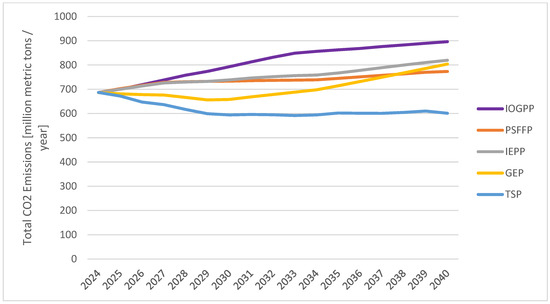
Figure 9.
Total CO2 emissions from scenarios.
These scenarios, modeled using EnergyPLAN, serve as essential tools for guiding policy decisions and facilitating a just and efficient energy transition. By addressing systemic inefficiencies, minimizing supply chain losses, and reducing end-use waste, Iran can improve overall energy performance, eliminate projected supply–demand imbalances, and significantly lower greenhouse gas emissions.
4.3. Policy Recommendations
To effectively operationalize the Transition Scenario Policy (TSP), which integrates fossil fuel optimization, renewable energy expansion, subsidy reform, and energy efficiency, a coordinated and multi-sectoral policy package is required. The following strategic policy recommendations are proposed to ensure a balanced and sustainable energy transition in Iran:
- Phased energy subsidies reform:
- o
- Gradually increase the prices of electricity, natural gas, petroleum, and oil products by at least 50%, reflecting true production and environmental costs.
- o
- Pair price adjustments with targeted social protection mechanisms to shield vulnerable groups from energy poverty.
- Enhancing power efficiency and reduction in energy waste and losses:
- o
- Upgrade and optimize thermal and combined-cycle power plants to improve fuel-to-energy conversion rates.
- o
- Prioritize public and private investment in high-efficiency technologies.
- o
- Implement advanced infrastructure and a smart grid to monitor electricity and gas networks in real time for the early detection of technical losses.
- o
- Launch national programs to reduce gas flaring through recovery and reinjection technologies.
- Strengthening energy efficiency regulations:
- o
- Enforce mandatory efficiency standards for energy-intensive industries, equipment, and processes.
- o
- Develop building codes that mandate energy efficiency standards in both new construction and retrofitting.
- Industrial and transport sector reforms:
- o
- Establish energy management systems in high-consumption industries to optimize resource use and reduce emissions.
- o
- Improve the efficiency of internal combustion engines through regulation, innovation, and incentives for hybrid/electric vehicles.
- Accelerating renewable energy deployment:
- o
- Allocate a portion of savings from fossil fuel subsidy reform to finance renewable energy projects.
- o
- Introduce long-term power purchase agreements and more feed-in tariffs to guarantee returns on renewable electricity.
- Enabling private sector participation:
- o
- Simplify regulations and remove barriers to private sector entry into the renewable energy market.
- o
- Foster public–private partnerships and provide fiscal incentives to de-risk clean energy investments.
5. Conclusions
This study assessed five energy transition scenarios for achieving sustainable development in oil-dependent countries, with Iran as a case study. Using the EnergyPLAN software and expert input, the scenarios were evaluated based on their effectiveness in reducing carbon emissions, addressing energy supply–demand imbalances, and promoting sustainability. The findings indicate that no single policy is sufficient; instead, a coordinated combination of measures, including the expansion of renewable energy, the enhancement of energy efficiency, and the phased removal of fossil fuel subsidies, is essential for achieving a low-carbon, balanced energy system by 2040. The Transition Scenario Policy (TSP), which integrates elements from all other scenarios, emerged as the most viable pathway toward sustainable development. These results underscore the importance of multi-stakeholder engagement and comprehensive policy integration. However, the successful realization of these outcomes depends on the timely and effective implementation of the proposed reforms, as well as the ability to navigate economic, political, and technological uncertainties.
Author Contributions
Conceptualization, B.H. and M.A.K.; methodology, B.H.; validation, F.G.; formal analysis, F.G.; writing—original draft preparation, B.H.; writing—review and editing, F.G. All authors have read and agreed to the published version of the manuscript.
Funding
This research received no external funding.
Data Availability Statement
The original contributions presented in the study are included in the article, further inquiries can be directed to the corresponding author.
Conflicts of Interest
The authors declare no conflicts of interest.
References
- UN. Investment Policies for Energy Transition; UN: New York, NY, USA, 2023. [Google Scholar]
- Pan, X.; Shao, T.; Zheng, X.; Zhang, Y.; Ma, X.; Zhang, Q. Energy and sustainable development nexus: A review. Energy Strategy Rev. 2023, 47, 101078. [Google Scholar] [CrossRef]
- Makki, M.; Kaspard, J.; Khalil, F.; Mawad, J.L. Renewable Energy Consumption Determinants: Do They Differ between Oil-Exporting Countries and Oil-Importing Ones? Sustainability 2024, 16, 7295. [Google Scholar] [CrossRef]
- Oteng, C.; Iledare, O.; Peprah, J.A.; Gamette, P. Towards Just Energy Transition: Renewable Energy Transition Dynamics and Sectorial Employment in Ghana. Sustainability 2024, 16, 3761. [Google Scholar] [CrossRef]
- Kang, Y. Sustainable Development Through Energy Transition: The Role of Natural Resources and Gross Fixed Capital in China. Sustainability 2025, 17, 83. [Google Scholar] [CrossRef]
- Kiss, T.; Popovics, S. Evaluation on the effectiveness of energy policies—Evidence from the carbon reductions in 25 countries. Renew. Sustain. Energy Rev. 2021, 149, 111348. [Google Scholar] [CrossRef]
- US. Reducing Greenhouse Gases in the United States: A 2035 Emissions Target. 2021. Available online: https://unfccc.int/sites/default/files/2024-12/United%20States%202035%20NDC.pdf (accessed on 15 May 2025).
- Fam, A.; Fam, S. Review of the US 2050 long term strategy to reach net zero carbon emissions. Energy Rep. 2024, 12, 845–860. [Google Scholar] [CrossRef]
- Hassan, Q.-U. A review and analysis of renewable energy policies and CO2 emissions of Pakistan. Energy 2022, 238, 121849. [Google Scholar] [CrossRef]
- Clo, S.; Fumagalli, E. The effect of price regulation on energy imbalances: A Difference in Differences design. Energy Econ. 2019, 81, 754–764. [Google Scholar] [CrossRef]
- Iwaro, J.; Mwasha, A. A review of building energy regulation and policy for energy conservation in developing countries. Energy Policy 2010, 38, 7744–7755. [Google Scholar] [CrossRef]
- Lin, B.; Jiang, Z. Estimates of energy subsidies in China and impact of energy subsidy reform. Energy Econ. 2011, 33, 273–283. [Google Scholar] [CrossRef]
- Liu, W.; Li, L. Improving energy consumption structure: A comprehensive assessment of fossil energy subsidies reform in China. Energy Policy 2011, 39, 4134–4143. [Google Scholar] [CrossRef]
- Raei, H.; Maleki, A.; Farajzadeh, Z. Analysis of energy policy reform in Iran: Energy and emission intensity changes. Econ. Anal. Policy 2024, 81, 1535–1557. [Google Scholar] [CrossRef]
- Fattouh, B.; El-Katiri, L. Energy subsidies in the Middle East and North Africa. Energy Strategy Rev. 2013, 2, 108–115. [Google Scholar] [CrossRef]
- Mahdavi, R. The Investigation of Impact of Complement Policy for Energy Price Policy Reform on Transport Sector in Iran by Computable General Equilibrium. Iran. Energy Econ. 2014, 3, 12. [Google Scholar]
- Sarrakh, R.; Renukappa, S.; Suresh, S.; Mushatat, S. Impact of subsidy reform on the kingdom of Saudi Arabia’s economy and carbon emissions. Energy Strategy Rev. 2020, 28, 100465. [Google Scholar] [CrossRef]
- Solaymani, S. A Review on Energy and Renewable Energy Policies in Iran. Sustainability 2021, 13, 7328. [Google Scholar] [CrossRef]
- Galeazzi, C.; Steinbuks, J.; Anadon, L.D. Assessing the impact of renewable energy policies on decarbonization in developing countries. Renew. Sustain. Energy Rev. 2024, 199, 114444. [Google Scholar] [CrossRef]
- Auty, R. Natural Resources, Capital Accumulation and the Resource Curse. Ecol. Econ. 2007, 61, 627–634. [Google Scholar] [CrossRef]
- Brundtland Commission. Report of the World Commission on Environment and Development. 1987. Available online: https://www.are.admin.ch/are/en/home/media/publications/sustainable-development/brundtland-report.html (accessed on 15 May 2025).
- IRENA. World Energy Outlook; IRENA: Masdar City, United Arab Emirates, 2023. [Google Scholar]
- Palomo, E.; Colmenar-Santos, A.; Rosales-Asensio, E. Thermal Desalination Potential with Parabolic Trough Collectors and Geothermal Energy in the Spanish Southeast. In Potential of Low-Medium Enthalpy Geothermal Energy; Green Energy and Technology; Springer: Cham, Switzerland, 2022. [Google Scholar]
- Oppong, R.; Asante, B.; Ackah, I. Addressing Energy Availability, Accessibility and Affordability Amidst Energy Transition in Africa: Ghana’s Outlook. In Proceedings of the SPE Nigeria Annual International Conference and Exhibition, Lagos, Nigeria, 31 July–2 August 2023. [Google Scholar] [CrossRef]
- Madurai Elavarasan, R.; Nadarajah, M.; Pugazhendhi, R.; Sinha, A.; Gangatharan, S.; Chiaramonti, D.; Abou Houran, M. The untold subtlety of energy consumption and its influence on policy drive towards Sustainable Development Goal 7. Appl. Energy 2023, 334, 120698. [Google Scholar] [CrossRef]
- Schwarz, J.S.; Witt, T.; Nieße, A.; Geldermann, J.; Lehnhoff, S.; Sonnenschein, M. Towards an Integrated Development and Sustainability Evaluation of Energy Scenarios Assisted by Automated Information Exchange. In Smart Cities, Green Technologies, and Intelligent Transport Systems; Communications in Computer and Information Science; Springer: Cham, Switzerland, 2019. [Google Scholar]
- Hong, J.H.; Kim, J.; Son, W.; Shin, H.; Kim, N.; Lee, W.K.; Kim, J. Long-term energy strategy scenarios for South Korea: Transition to a sustainable energy system. Energy Policy 2019, 127, 425–437. [Google Scholar] [CrossRef]
- Pîrlogea, C.; Radu, A.L. Shaping a sustainable energy future: Premises and scenarios. Qual. Access Success 2011. Available online: https://www.researchgate.net/publication/295166881_Shaping_a_sustainable_energy_future_Premises_and_scenarios (accessed on 15 May 2025).
- Artyukhova, N.; Tiutiunyk, I.; Bogacki, S.; Kovalenko, Y. Scenario Modeling of Energy Policies for Sustainable Development. Energies 2022, 15, 7711. [Google Scholar] [CrossRef]
- Hadian, S.; Madani, K. The water demand of energy: Implications for sustainable energy policy development. Sustainability 2013, 5, 4674–4687. [Google Scholar] [CrossRef]
- Silberglitt, R.; Kimmel, S. Energy scenarios for Southeast Asia. Technol. Forecast. Soc. Change 2015, 101, 251–262. [Google Scholar] [CrossRef]
- Roubíček, V.; Kolat, P.; Čech, B.; Raclavská, H. Some experience from the co-combustion process diagnostic. In Proceedings of the 22nd Annual International Pittsburgh Coal Conference 2005, PCC 2005, Pittsburgh, PA, USA, 12–15 September 2005. [Google Scholar]
- Tran, T.T.; Namazu, M.; Matsuoka, Y. Socio-economic and energy scenario development in Vietnam. WIT Trans. Ecol. Environ. 2011, 143, 253–264. [Google Scholar]
- Raza, M.A.; Aman, M.M.; Rajpar, A.H.; Jumani, T.A. Towards Achieving 100% Renewable Energy Supply for Sustainable Climate Change in Pakistan. Sustainability 2022, 14, 16547. [Google Scholar] [CrossRef]
- Faraji Abdolmaleki, S.; Esfandiary Abdolmaleki, D.; Bello Bugallo, P.M. Finding Sustainable Countries in Renewable Energy Sector: A Case Study for an EU Energy System. Sustainability 2023, 15, 10084. [Google Scholar] [CrossRef]
- Mihai, D.M.; Doran, M.D.; Puiu, S.; Doran, N.M.; Jianu, E.; Cojocaru, T.M. Managing Environmental Policy Stringency to Ensure Sustainable Development in OECD Countries. Sustainability 2023, 15, 15427. [Google Scholar] [CrossRef]
- Gielen, D.; Boshell, F.; Saygin, D.; Bazilian, M.D.; Wagner, N.; Gorini, R. The role of renewable energy in the global energy transformation. Energy Strategy Rev. 2019, 24, 38–50. [Google Scholar] [CrossRef]
- Goldthau, A.; Westphal, K. Why the Global Energy Transition does not mean the End of the Petrostate. Glob. Policy 2019, 10, 279–283. [Google Scholar] [CrossRef]
- Hafner, M.; Wochner, A. How tectonic shifts in global energy are affecting global governance. In Global Governance in Transformation; Grigoriev, L., Pabst, A., Eds.; Springer: Berlin/Heidelberg, Germany, 2020; pp. 147–162. [Google Scholar]
- Tovar-Facio, J.; Martín, M.; Ponce-Ortega, J.M. Sustainable energy transition: Modeling and optimization. Curr. Opin. Chem. Eng. 2021, 31, 100661. [Google Scholar] [CrossRef]
- Davidsdottir, B.; Ásgeirsson, E.I.; Fazeli, R.; Gunnarsdottir, I.; Leaver, J.; Shafiei, E.; Stefánsson, H. Integrated Energy Systems Modeling with Multi-Criteria Decision Analysis and Stakeholder Engagement for Identifying a Sustainable Energy Transition. Energies 2024, 17, 4266. [Google Scholar] [CrossRef]
- Arias, A.; Feijoo, G.; Moreira, M.T. Advancing the European energy transition based on environmental, economic and social justice. Sustain. Prod. Consum. 2023, 43, 77–93. [Google Scholar] [CrossRef]
- Genc, T.S.; Kosempel, S. Energy Transition and the Economy: A Review Article. Energies 2023, 16, 2965. [Google Scholar] [CrossRef]
- Lund, H.; Thellufsen, J.Z.; Østergaard, P.A.; Sorknæs, P.; Skov, I.R.; Mathiesen, B.V. EnergyPLAN—Advanced analysis of smart energy system. Smart Energy 2021, 1, 100007. [Google Scholar] [CrossRef]
- Connolly, D.; Lund, H.; Mathiesen, B.V.; Leahy, M. A review of computer tools for analysing the integration of renewable energy into various energy systems. Appl. Energy 2010, 87, 1059–1082. [Google Scholar] [CrossRef]
- Karanfil, F.; Omgba, L.D. The energy transition and export diversification in oil-dependent countries: The role of structural factors. Ecol. Econ. 2023, 204, 107681. [Google Scholar] [CrossRef]
- Farzaneh-Gord, M.; Arabkoohsar, A.; Dasht-bayaz, M.D.; Machado, L.; Koury, R.N.N. Nergy and exergy analysis of natural gas pressure reduction points equipped with solar heat and controllable heaters. Renew. Energy 2014, 72, 258–270. [Google Scholar] [CrossRef]
- Ezeh, M.; Ogbu, A.D.; Ikevuje, A.H.U. Emmanuel Paul-Emeka George, Stakeholder engagement and influence: Strategies for successful energy projects. Int. J. Manag. Entrep. Res. 2024, 6, 2375–2395. [Google Scholar] [CrossRef]
- Sadeghzadeh, S.; Golkar, K.; Ghaffari, A. Tools for the governance of urban design: The tehran experience. Armanshahr 2018, 11, 69–80. [Google Scholar]
- British Petroleum (BP). Statistical Review of World Energy; British Petroleum: London, UK, 2023. [Google Scholar]
- Iran’s Energy Balance Sheet; National Development Fund of Iran on the Balance of Oil, Ministry of Energy: Tehran, Iran, 2021. Available online: https://pep.moe.gov.ir/%D8%A7%D9%86%D8%AA%D8%B4%D8%A7%D8%B1%D8%A7%D8%AA/%DA%86%D9%87%D8%A7%D8%B1-%D8%AF%D9%87%D9%87-%D8%AA%D8%B1%D8%A7%D8%B2%D9%86%D8%A7%D9%85%D9%87-%D8%A7%D9%86%D8%B1%DA%98%DB%8C/%D8%AA%D8%B1%D8%A7%D8%B2-%D8%A7%D9%86%D8%B1%DA%98%DB%8C-%D8%B3%D8%A7%D9%84-1400 (accessed on 15 May 2025).
- Natural Gas Report. Document on the Balance of Natural Gas Production and Consumption in the Country until the Horizon of 2040. 2019. Available online: https://www.eia.gov/outlooks/ieo/pdf/nat_gas.pdf (accessed on 15 May 2025).
- NIOPDC. National Iranian Oil Products Distribution Company Report; NIOPDC: Tehran, Iran, 2023. [Google Scholar]
- Amadeh, H.; Tavakolian, H.; Nia, M.H. Dynamic Analysis of the Fuel Substitution in the Selected Iranian Fossil Fuel Power Plants. Iran. J. Energy Econ. 2019, 8, 1–30. [Google Scholar] [CrossRef]
- AlaEhsan, S.; Reza, L.M.; Ali, F.M.; Sohrab, E. The Optimal Allocation of Iran’s Natural Gas. Iran. Econ. Rev. 2020, 24, 75–98. [Google Scholar]
- UNDP. Strengthening Energy Governance Systems Report; UNDP: New York, NY, USA, 2023. [Google Scholar]
- Souhankar, A.; Mortezaee, A.; Hafezi, R. Potentials for energy-saving and efficiency capacities in Iran: An interpretive structural model to prioritize future national policies. J. Energy 2023, 262, 125500. [Google Scholar] [CrossRef]
- NDF. NDF Report. In National Development Fund of Iran (NDF); NDF: Tehran, Iran, 2022. [Google Scholar]
- Halder, P.; Prokop, P.; Chang, C.Y.; Usak, M.; Pietarinen, J.; Havu-Nuutinen, S.; Cakir, M. International survey on bioenergy knowledge, perceptions, and attitudes among young citizens. BioEnergy Res 2012, 5, 247–261. [Google Scholar] [CrossRef]
- Nakata, T.; Silva, D.; Rodionov, M. Application of energy system models for designing a low-carbon society. Prog. Energy Combust. Sci. 2011, 37, 462–502. [Google Scholar] [CrossRef]
- Tzanakis, I.; Hadfield, M.; Thomas, B.; Noya, S.M.; Henshaw, I.; Austen, S. Future perspectives on sustainable tribology. Renew. Sustain. Energy Rev. 2012, 16, 4126–4140. [Google Scholar] [CrossRef]
- Michael Gerald Pollitt. The role of policy in energy transitions: Lessons from the energy liberalization era. Energy Policy 2012, 50, 128–137. [Google Scholar] [CrossRef]
- Yazdanpanah, M.; Komendantova, N.; Ardestani, R.S. Governance of energy transition in Iran: Investigating public acceptance and willingness to use renewable energy sources through socio-psychological model. Renew. Sustain. Energy Rev. 2015, 45, 565–573. [Google Scholar] [CrossRef]
- Kaldellis, J.K.; Kapsali, M.; Kaldelli, E.L.; Katsanou, E.V. Comparing recent views of public attitude on wind energy, photovoltaic and small hydro applications. Renew. Energy 2013, 52, 197–208. [Google Scholar] [CrossRef]
- Battaglini, A.; Komendantova, N.; Brtnik, P.; Patt, A. Perception of barriers for expansion of electricity grids in the European Union. Energy Policy 2012, 47, 254–259. [Google Scholar] [CrossRef]
- Delafield, G.; Donnison, C.; Roddis, P.; Logan, K.G. Conceptual framework for balancing society and nature in net-zero energy transitions. Environ. Sci. Policy 2021, 125, 189–201. [Google Scholar] [CrossRef]
- Bang, H.-K.; Ellinger, A.E.; Hadjimarcou, J.; Traichal, P.A. Consumer concern, knowledge, belief, and attitude toward renewable energy: An application of the reasoned action theory. Emerg. Issues Mark. 2000, 17, 6. [Google Scholar] [CrossRef]
- Saphores, J.-D.M.; Nixon, H. How effective are current household recycling policies? Results from a national survey of U.S. households, Resources. Conserv. Recycl. 2014, 92, 1–10. [Google Scholar] [CrossRef]
- Tampakis, S.; Arabatzis, G.; Tsantopoulos, G.; Rerras, I. Citizens’ views on electricity use, savings and production from renewable energy sources: A case study from a Greek island. Renew. Sustain. Energy Rev. 2017, 79, 39–49. [Google Scholar] [CrossRef]
Disclaimer/Publisher’s Note: The statements, opinions and data contained in all publications are solely those of the individual author(s) and contributor(s) and not of MDPI and/or the editor(s). MDPI and/or the editor(s) disclaim responsibility for any injury to people or property resulting from any ideas, methods, instructions or products referred to in the content. |
© 2025 by the authors. Licensee MDPI, Basel, Switzerland. This article is an open access article distributed under the terms and conditions of the Creative Commons Attribution (CC BY) license (https://creativecommons.org/licenses/by/4.0/).